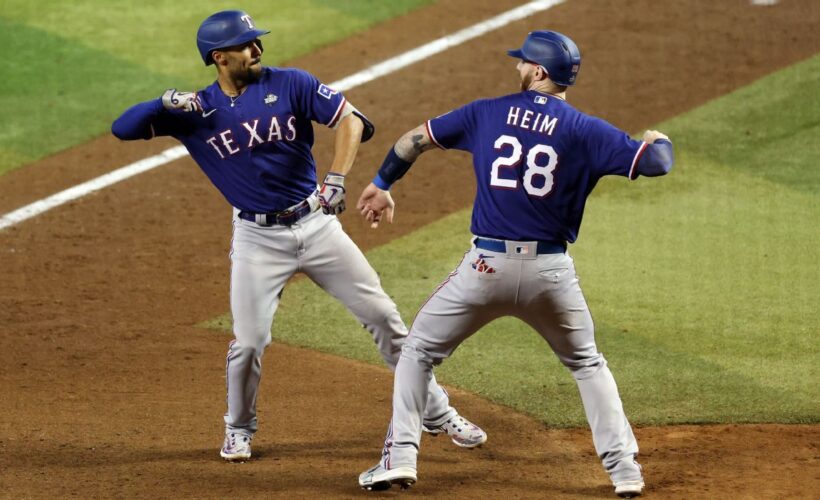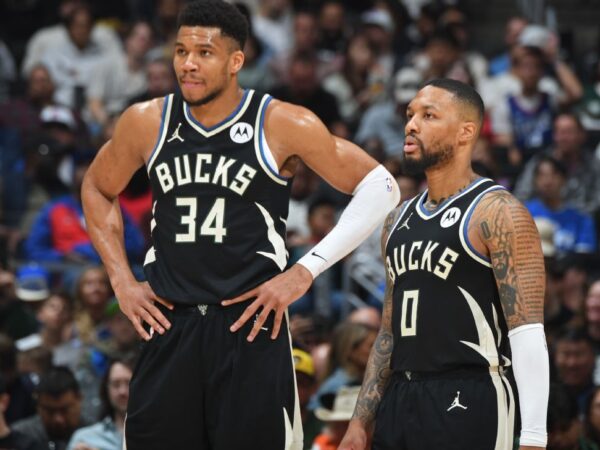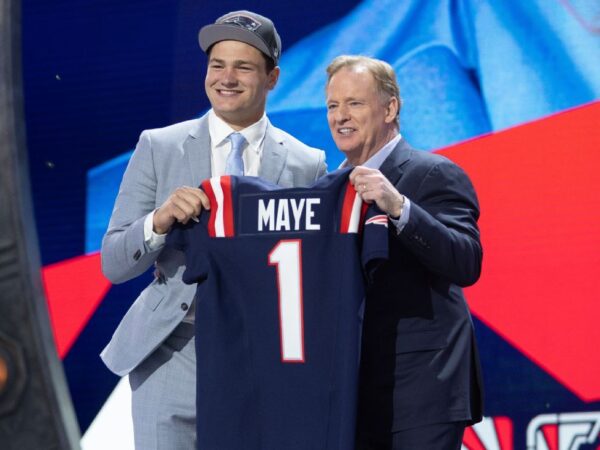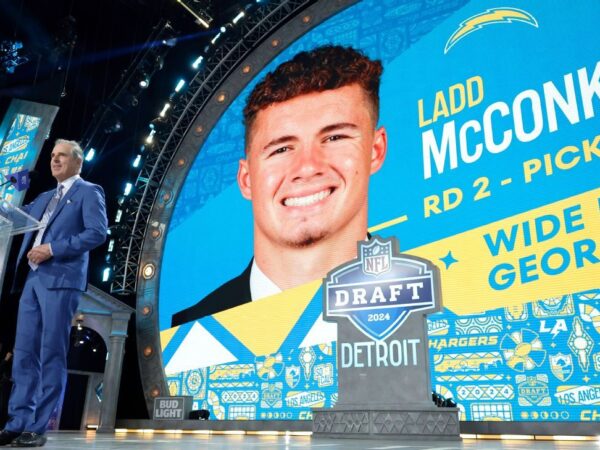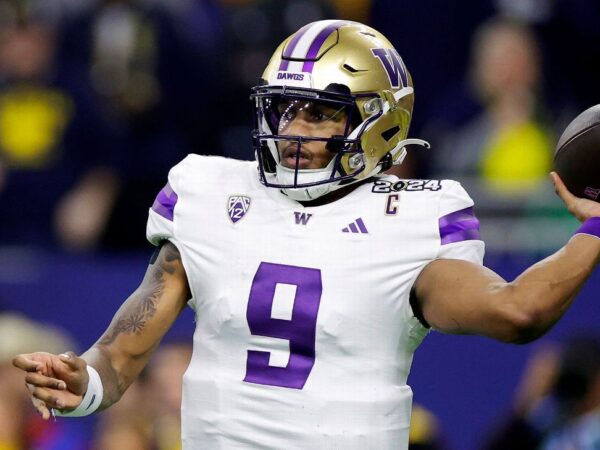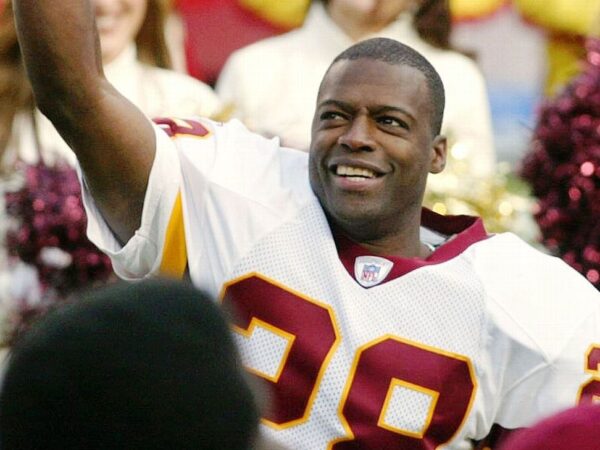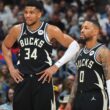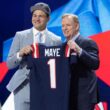PHOENIX — There is no one way to rebuild a baseball team, and there is no one way to exit that rebuild and ramp up to contention. There is perhaps a sentiment common to the start of any such project, though, one expressed nine months ago in four words by the general manager of baseball’s newest champions, the Texas Rangers.
“We’re sick of losing,” Chris Young said at spring training in Arizona, answering a reporter’s question about how and why the Rangers took an aggressive stance to free agency the winter before.
Nine months later, that sickness has been cured.
The road between that statement in February and Wednesday night’s pileup at Chase Field in downtown Phoenix — only 37 miles away from the spring training facility where it was spoken — was long, meandering and filled with potholes.
In the end, though, those four words were profound enough to point the way to a new destination for the Rangers — the domain of World Series champions.
“Everybody wants to be a winner,” Texas reliever Will Smith said. “That’s what you want to be known for, is a guy who wins. … It’s a whole lot better than losing.”
Smith, incidentally, knows a thing or two about winning. He has now been on the roster of three straight championship teams — the Atlanta Braves (2021), the Houston Astros (2022) and now the Rangers.
“It’s something I don’t take for granted, for sure,” Smith said.
He shouldn’t. Winning the World Series is hard. Entering the 2023 season, six of the 30 existing MLB franchises had never won a World Series. The Rangers, who began their existence with 11 lackluster seasons as the neo-Washington Senators, had played about 1,300 more games than any of the other titleless teams. In fact, if you zoom in on the 51 campaigns Texas played in Arlington before this season, it represents the longest wait any American League fan base has ever endured for that first World Series title.
That wait, as of Wednesday, is over.
You don’t think of the Rangers as perennial losers. They’ve employed several of the more larger-than-life managers we’ve ever had in baseball, from Ted Williams to Billy Martin to Whitey Herzog to Bobby Valentine, Ron Washington, Buck Showalter and, especially, their current skipper, four-time champion Bruce Bochy. Some of the biggest stars of the past half-century have played for the Rangers, including Ivan Rodriguez, Nolan Ryan, Jose Canseco, Alex Rodriguez, Adrian Beltre, Frank Howard (who died during this World Series at age 87) and Ferguson Jenkins. Heck, one of their former owners used to be president of the United States.
Yet, somehow, until Wednesday, these elements had never coalesced into championship form. And until, well, not very long before Wednesday, there had been little evidence that would change any time soon. Entering this season, the Rangers’ five-year winning percentage (.417, or 67.5 wins per 162 games) was the franchise’s worst since 1974, its third season after the move from Washington.
Now, after all of those requited summers baking in the hot Arlington sun, that title thirst has finally been quenched. In the aftermath of seasons with 102 and 94 losses, the Rangers are champs. How did this Texas-sized turnaround happen so fast?
Winter 2021
Starting with the 2021-22 offseason signings of Corey Seager, Marcus Semien and Jon Gray by former lead exec Jon Daniels, the Rangers had in essence started to put the finishing touches on a work in which the outlines were not year clear.
Certainly there was hope that the player development system was going to start yielding key contributors, and it has. But when Seager and Semien committed to the Rangers, they were being sold on a vision, not a track record.
Jon Daniels was calling the front office shots at the time, with Young his top lieutenant, but even as the previous rebuild was faltering, a newer, quicker and, let’s face it, more expensive version was well underway.
“Meeting the Texas Rangers and listening to Chris Young, it definitely aligned with what I wanted to do as a player,” Semien told ESPN in September. “He said he wanted pitching, too. He has done everything he said and Ray Davis, our owner, has been on board too. When you play for an organization that is moving forward and wanting to win, that’s exactly where you want to be.”
If anything, if there is a takeaway for other teams from the Rangers’ sudden success, it’s that if you believe in your system, you don’t have to wait to invest in the roster.
“To some extent it was to accelerate the rebuild,” Young said back in September. “In a market this size, I think that our fans deserve that. They shouldn’t have to go through a five-, six-, seven-year rebuild.
“Part of it was because we felt very good about our player development system, and the group of players that we had on the cusp of the big leagues, and we felt like accelerating their development would be facilitated by having the right veteran players around.”
Winter 2022
Despite 94 losses in 2022, the Rangers had in place the makings of a solid offense, in large part because of Seager and Semien’s success. Texas finished eighth with 198 homers and scored runs at a clip safely above the MLB average — and those two players set examples for the younger Rangers coming through the system.
“When your best players, the players you’re counting on the most like Seager and Semien, work extremely hard and they care deeply, your team always has a chance to reach its ceiling,” Rangers senior advisor of baseball operations Dayton Moore, architect of a title-winning team in Kansas City, said. “Semien and Seager are as committed as players as I’ve ever been around. Watching them throughout the season, their work ethic is unbelievable.”
On the pitching side, Young’s club needed more T.L.C., where the Rangers were a bottom-10 team by ERA+. In response, Young dealt for righty Jake Odorizzi early in the offseason. Then, with the blessing of owner Ray Davis, Young went hard in free agency in the spring, landing, in order, Jacob deGrom, Andrew Heaney and Nathan Eovaldi. That quartet, along with 2022 holdovers like Jon Gray, Martin Perez and Dane Dunning gave the Rangers one of the deepest and most accomplished core rotations in the majors.
“We went into the offseason knowing that we needed to improve our starting pitching,” Young said during the ALCS. “It was a big limitation for us last year. We knew that we had scored runs and we were going to have pretty much the same offensive team back. So the key to us being a good team was going to be to improve our starting pitching. We obviously were very active in the free agent market.”
Based on those acquisitions alone, the Texas baseline win projection moved into the .500 range — and that was without considering the late October news that Bochy had signed on to return to the dugout and guide the team.
The biggest splash on the acquisition list was deGrom, arguably the best pitcher in baseball when he’s able to stay on the mound. Since the beginning of the 2018 season, deGrom has a composite 2.08 ERA with 290 strikeouts per 162 games. That’s not merely ace material, that’s Cooperstown stuff.
The Rangers hit spring training with their brand-new rotation and their legendary manager — and then the depth chart began to thin before the season even began. Odorizzi went down with a bum shoulder that ended up requiring season-ending surgery.
It was only the first such challenge for the Rangers.
Spring 2023
Losing Odorizzi stung, but the Rangers still had good rotation depth as the season began. They still had a dream October one-two punch in deGrom and Eovaldi — as long as they could get to October.
Then, on April 28, a win over the Yankees, deGrom threw his last pitch of the season, leaving early because of two dreaded words: forearm tightness. He tried to work his way back, throwing a bullpen session in late May. In June, he underwent Tommy John surgery.
DeGrom had been the latest marquee free agent to be wooed by not just Davis’ dollars, but also Young’s plans to build a sustainable contender. He was a big part of that plan, an irreplaceable component, if lost, from any team’s rotation.
Even when the roster-building plan is perfect, things go wrong. The ineffable quality of a championship team is something else, something more elusive. That something can be called clubhouse chemistry or team culture or what the players might call the “next man up mentality.” How you create it or how you even define it is hard to say, but invariably, a championship team is going to have it.
So how did the Rangers respond? By June 12, the date of deGrom’s surgery, Texas owned the second-best rotation ERA in baseball (3.38), leading all teams in innings from starters and ranking fourth in quality starts.
All of those measures remained strong through the All-Star break, partially because Eovaldi and Gray were pitching like All-Stars and because Dunning, who stepped into deGrom’s place in the rotation, owned a sub-3.00 ERA.
“A few guys go down, but you’ll have to face a little adversity in the season to have success,” said Eovaldi, a key member of the 2018 champion Red Sox. “I feel that was one of our main things this year, we had a lot of key players, not just even pitchers, but a lot of guys step up when one of the guys went down and filled in the role nicely.”
It wasn’t just the pitching staff. In April, Seager turned up with a sore hamstring that kept him out of the lineup for several weeks. With DeGrom ailing as well, the Rangers were pressing ahead in the rugged AL West without their most talented pitcher and most talented hitters.
And what happened? Rookie Josh Jung, Bochy’s everyday third baseman from the outset, flourished, posting 12 homers and 37 RBIs by the end of May and diving around the field on defense, doing the best imitation he could of his historical hero, Brooks Robinson. Semien mashed, too, and the Rangers went 20-13 during Seager’s lengthy absence, with utility player Ezequiel Duran hitting .305/.342/.533 during that time. Next man up, indeed.
By the All-Star break, the Rangers were leading the majors in runs.
“We’re just resilient,” Seager said. “We’ve talked about it all year. Just playing good baseball, trying to win series and having a pass the baton mentality. You don’t have to be the guy every night. It’s just kind of translated for us.”
Summer 2023
Eovaldi caught fire as the season progressed towards the All-Star break, establishing himself as a likely contender for the AL Cy Young Award.
Not surprisingly, that run started in the immediate aftermath of deGrom’s injury. On April 29, Eovaldi threw a three-hit shutout against the Yankees. From that game through July 18, his first start of the second half, Eovaldi went 9-1 with a 1.97 ERA. Ace stuff. Cy Young stuff.
Then Eovaldi, too, got hurt. During that July 18 start, he threw six shutout frames against Tampa Bay, but his velocity was down. A start was skipped. A forearm strain was reported. He didn’t pitch again until September.
When Eovaldi went down, Texas was 19 games over .500 and led the division by 4½ games with the trade deadline looming two weeks away. And then it all started to turn.
The star-starved rotation began to suffer, and the Rangers bled runs at an alarming rate. Texas lost its last three games going into deadline day. Their lead over archrival Houston had shrunk to one game.
So what happened? Young doubled and tripled down on an already expensive rotation, dealing for Max Scherzer and Jordan Montgomery. Rather than rest on the talent, Young made the Rangers one of the clear winners of deadline machinations.
“By the time we got to the deadline, we needed to re-address our rotation, so that’s what we did,” Young said, his matter-of-fact tone implying that every team goes out and trades for two All-Star starters midstream.
The Rangers won on deadline day, the first of eight straight wins. They won 12 of 14 overall to move a season-high 24 games over .500 by the middle of August. Things were good, the new order suggested by the Rangers strong first half seemingly restored by Young’s characteristic aggression at the deadline.
As it turned out, the Rangers’ rollercoaster was just starting to roll. After hitting that high point on Aug. 15, Texas lost nine straight (including twice to Arizona, the team they just vanquished in the Fall Classic). They fell into a tie in what had become a three-team struggle with Houston and Seattle.
The slump just kept getting worse. From Aug. 16 through Sept. 8, Texas lost 16 of 20. During those games, the Rangers’ staff put up a 6.33 ERA. Only four teams put a lower OPS at the plate. What had seemed like a surefire playoff spot was no longer assured.
Nothing was clicking. Bochy’s pitching staff was on fumes. It all came to a head during what Young refers to as “the disaster series.”
Houston was in town. Despite the Rangers’ slump, they were still in good position, and a strong series against the Astros not only would put Houston in a major hole, but it could restore some of the Rangers’ earlier momentum.
Over the next three days, despite Eovaldi’s return to action and a marquee matchup that pitted Scherzer against Justin Verlander, Houston outscored the Rangers 39-10, a frightening differential that looks even worse when you consider that Texas led the first game 3-0 at one point.
Injuries (Heim and Jung, among them) played a big part in the skid, but Texas looked very much like a team that had fallen into an irreversible spiral.
There was no one moment that pulled them out. Texas started to get healthier, at least on offense, though Scherzer was lost with a shoulder injury that everyone thought would end his season. Young called up top prospect Evan Carter. Eovaldi began to round into form. Montgomery performed like the top-of-the-rotation starter Texas badly needed. The Rangers won six straight and regained their lead in the AL West.
“I think we had to deal with more this year than any year I’ve ever had to manage,” Bochy said. “And that’s what makes me proud of these guys, too, how they were focused on that as much as, hey, let’s focus forward. And they kept doing that.”
Carter was a revelation almost from the start, hitting .306/.413/.645 down the stretch while flashing plus speed on basepaths and defense in the outfield. The system Young had bet on was paying off again.
So, too, was the Rangers’ emergent clubhouse culture where in a room peopled by some of the game’s biggest stars, rookies like Carter and Jung, and reinforcements like Duran and Travis Jankowski felt right at home. Next man up, yes, but it was every man up as well.
“It shows that no matter who we have on the field, we’re going to compete,” Carter said. “A team like us, we’ve got the Coreys, the Marcuses that are so high up there in the baseball world, it’s kind of easy to overlook the other people who are really good contributors. Obviously Corey and Marcus are huge reasons for our success but at the same time, we had people come in and contribute in all kinds of ways.”
October 2023
The Rangers had an up-and-down finish to the regular season and missed a chance to win the AL West outright by dropping a 1-0 game in Seattle on the season’s final day. They tied the Astros for the division lead, but Houston owned the tiebreaker (in part because of the disaster series).
Instead of resting at home in the wild card round, Texas boarded a plane in Seattle, enduring one of baseball’s longest flights: across the continent for a winner-takes-all series against the Tampa Bay Rays in St. Petersburg, Florida.
The Rangers took two straight, swept the Rays, then won two on the road against the Baltimore Orioles in the next round. By Game 3 of the ALCS, the Rangers had played only one game at home — and had won every single road game they played in three other cities.
There were still more setbacks at the very end of the Rangers’ run. Adolis Garcia, who, along with Seager, powered the Texas offense in October was lost to an oblique injury suffered in Game 3 of the World Series. Scherzer, who shockingly returned during the ALCS, had his back lock up in the same game.
Both players were removed from the Texas roster simultaneously before Game 4 against the Diamondbacks.
And what happened? Bolstered by an emotional pregame speech by the devastated Garcia, the Rangers clubbed Arizona 11-7 in Game 4, and finished off the Snakes in Game 5. Injury after injury, setback after setback, this was one rapid rebuild that was not going to be denied.
Young, a native of the Dallas area and a former Rangers player, had delivered the franchise’s first title. Bochy had won his fourth. While you can look at the splashy free agent signings and the stars acquired through trade, moves that had Seager and Semien and Eovaldi and Scherzer and deGrom and Garcia dancing around the same clubhouse with Jankowski and Jung and Carter and everyone else, what is perhaps most impressive is not how quickly the talent was gathered, but how quickly that elusive thing — chemistry, comradery, culture, next-man-upness, whatever you want to call it — became this team’s manna, the fuel that helped them overcome more than their fair share of roadblocks.
It was the team Young built, in his first full season as Texas’ lead exec. Not a bad bit of work for a guy who was pitching in the majors just a few years ago. Even when he was still hurling for Moore’s teams in Kansas City, winning a title in 2015, the Royals’ title-winning GM knew Young had future exec written all over him.
“Everybody talks about how smart C.Y. is, but he’s got emotional intelligence too,” Rangers advisor Dayton Moore said. “You have to have a natural love and passion for this game, which he does. You have to have baseball wisdom, which he does. And then you also have to love people. He has all three, and he has a great work ethic. I think he’s got a chance to do this successfully for a long time.”
Young and his team have a tough act to follow after Wednesday, but one thing is certain: They aren’t going to get tired of winning any time soon.
Source:ESPN

